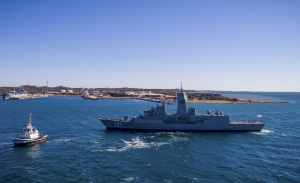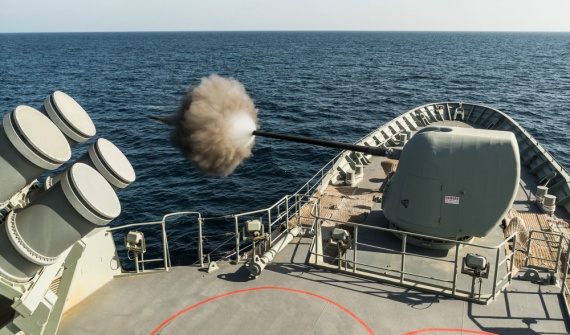HMAS Arunta (II)
| Class |
Anzac Class |
|---|---|
| Type | |
| Role | Long-range frigate capable of air defence, surface and undersea warfare, surveillance, reconnaissance and interdiction. |
| Pennant |
FFH 151 |
| International Callsign |
VKMQ |
| Motto |
Conquer or Die |
| Home Port | |
| Builder |
Tenix Defence Systems |
| Launched |
28 June 1996 |
| Commissioned |
12 December 1998 |
| Dimensions & Displacement | |
| Displacement | 3600 tonnes |
| Length | 118 metres |
| Beam | 14.8 metres |
| Draught | 4.5 metres |
| Performance | |
| Speed | 27 knots |
| Range | 6000 nautical miles |
| Complement | |
| Crew | 177 |
| Propulsion | |
| Machinery |
|
| Armament | |
| Missiles |
|
| Guns |
|
| Torpedoes | 2 x Mk32 Mod 5 triple mounted torpedo tubes |
| Physical Countermeasures |
|
| Electronic Countermeasures |
|
| Radars |
|
| Sonars |
|
| Combat Data Systems | Saab Systems 9LV453 Mk3E |
| Electro-optic Systems |
|
| Helicopters | 1 x MH-60R Seahawk |
| Awards | |
| Inherited Battle Honours | |
| Battle Honours | |
| Resources | |
| News Articles | |
| Image Gallery | |

HMAS Arunta (II) is the second of eight Anzac Class frigates built by Tenix Defence Systems at Williamstown, Victoria for the Royal Australian Navy. The design is based on the German Meko 200 frigate.
Arunta is a long-range frigate capable of air defence, surface and undersea warfare, surveillance, reconnaissance and interdiction. Arunta's combat capabilities have been significantly improved under the Anti-Ship Missile Defence upgrade program, a world class program that provides an enhanced sensor and weapons systems capability. The upgrade showcases Australian design and integration capability, with new Phased Array Radar technology designed by CEA Technologies in Canberra, upgrades to combat systems performed by Saab Systems in South Australia, and platform integration design by BAE Systems in Victoria.
Arunta is fitted with an advanced package of air and surface surveillance radars; omni-directional hull mounted sonar and electronic support systems that interface with the state-of-the-art 9LV453 Mk3E combat data system. The ship can counter simultaneous threats from aircraft, surface vessels and submarines.
The ship's main armament comprises one Mark 45 capable of firing 20 rounds per minute, ship launched Mark 46 torpedoes and a Mark 41 vertical launch system for the Evolved Sea Sparrow missile. Arunta also has eight anti-ship/land attack canister launched harpoon missiles. The ship's other defence systems include the Nulka active missile decoy system, offboard chaff and a torpedo countermeasures system.
HMAS Arunta, like her sister frigates HMA Ships Anzac, Ballarat, Parramatta, Perth, Stuart, Toowoomba and Warramunga features a "combined diesel or gas" (CODOG) propulsion plant which enables the ship to sustain sprint speeds of greater than 27 knots and allows an operational range in excess of 6,000 nautical miles at 18 knots.
The ship can embark Navy's latest multi-role Sikorsky/Lockheed Martin MH-60R Seahawk helicopter which has enhanced anti-submarine, anti-surface warfare and Search and Rescue capabilities. Embarkation of a helicopter also provides the ship with the capability to deliver air-launched missiles and torpedoes.
Arunta has completed three deployments to the Middle East region. In order to facilitate greater time on task for Australian ships, Arunta's most recent deployment, Rotation 64, was the first of an extended nine month rotation in the Middle East region.
HMAS Arunta was the first Anzac class frigate to complete the Anzac Mid-Life Capability Assurance Program (AMCAP) upgrade at the Australian Marine Complex in Henderson, Western Australia.
The upgrade was performed by the Warship Asset Management Agreement (WAMA) Alliance and included the replacement of the Long Range Air search radar, IFF (Identification, Friend or Foe) and secondary surveillance radar capabilities. Arunta also underwent a platform systems obsolescence program to improve platform reliability and maintainability. Work was also performed to improve the ship’s habitability for the crew as well as an upgrade to the ship’s communications systems to resolve a number of obsolescence issues.
In early June 2019, HMAS Arunta returned to her home port of Fleet Base West where she rejoined the fleet, begin conducting work-ups and testing the new equipment on-board.
Arunta is the second ship of the name. The original HMAS Arunta (I), commissioned in 1942, became one of the best known RAN ships in World War II . She served with distinction in New Guinea and the Pacific between 1942-1944, the Battle of Leyte Gulf in 1944 and Lingayen Gulf in 1945.
Origin of HMAS Arunta’s name
Selection of the Arunta name and original motto 'Conquer or Die' recognises the ship's proud history and the ongoing and special relationship with the Arrernte Aboriginal people of Central Australia.
The Arrernte region, based around Alice Springs, is large and traditionally there have been many different aboriginal groups within it, each with their own language dialect. Language is strongly connected with family membership and the relationships to land and dreamings that go with this. Arrernte is known as a nation in itself to Aboriginal communities of Central Australia. Within these boundaries the ancestors of the modern Arrernte have roamed, hunted, and performed their ceremonies, just as their living descendants do in the present day.
Arrernte have always been traditional custodians of many of the river beds of Central Australia. Art, myths and ceremonies are at the centre of the Arrernte culture which is as strong and diverse today as it has ever been.
The Arrernte region itself is large and diverse and covers an area from Tea Tree to the north of Alice Springs, west to the WA border, east to the Queensland border and south to Uluru.
To maintain the warm and special bond between HMAS Arunta and the Arrernte people the Arrernte Council presented HMAS Arunta with a flag displaying a perentie lizard. The lizard is an animal from the dreamtime for the Arrernte people.
HMAS Arunta also sponsors a perentie lizard, the ship's mascot, at Perth Zoo, Western Australia.






